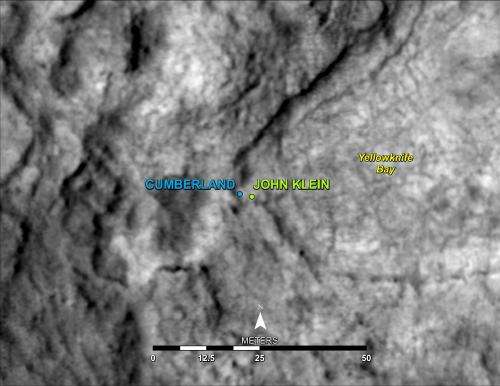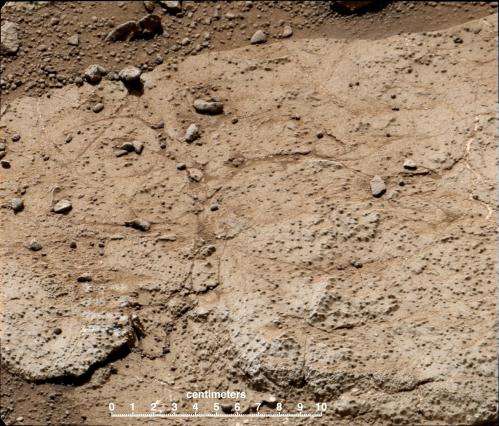Curiosity rover team selects second drilling target on Mars

(Phys.org) —The team operating NASA's Curiosity Mars rover has selected a second target rock for drilling and sampling. The rover will set course to the drilling location in coming days.
This second drilling target, called "Cumberland," lies about nine feet (2.75 meters) west of the rock where Curiosity's drill first touched Martian stone in February. Curiosity took the first rock sample ever collected on Mars from that rock, called "John Klein." The rover found evidence of an ancient environment favorable for microbial life. Both rocks are flat, with pale veins and a bumpy surface. They are embedded in a layer of rock on the floor of a shallow depression called "Yellowknife Bay."
This second drilling is intended to confirm results from the first drilling, which indicated the chemistry of the first powdered sample from John Klein was much less oxidizing than that of a soil sample the rover scooped up before it began drilling.
"We know there is some cross-contamination from the previous sample each time," said Dawn Sumner, a long-term planner for Curiosity's science team at the University of California at Davis. "For the Cumberland sample, we expect to have most of that cross-contamination come from a similar rock, rather than from very different soil."

Although Cumberland and John Klein are very similar, Cumberland appears to have more of the erosion-resistant granules that cause the surface bumps. The bumps are concretions, or clumps of minerals, which formed when water soaked the rock long ago. Analysis of a sample containing more material from these concretions could provide information about the variability within the rock layer that includes both John Klein and Cumberland.
Mission engineers at NASA's Jet Propulsion Laboratory in Pasadena, Calif., recently finished upgrading Curiosity's operating software following a four-week break. The rover continued monitoring the Martian atmosphere during the break, but the team did not send any new commands because Mars and the sun were positioned in such a way the sun could have blocked or corrupted commands sent from Earth.
Curiosity is about nine months into a two-year prime mission since landing inside Gale Crater on Mars in August 2012. After the second rock drilling in Yellowknife Bay and a few other investigations nearby, the rover will drive toward the base of Mount Sharp, a 3-mile-tall (5-kilometers) layered mountain inside the crater.
Provided by JPL/NASA





















